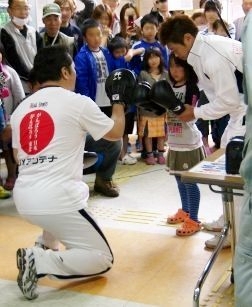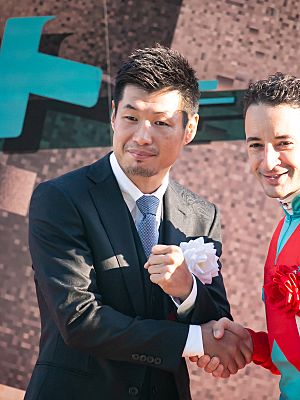Hozumi Hasegawa facts for kids
Hozumi Hasegawa (長谷川 穂積, Hasegawa Hozumi, born 16 December 1980) is a famous Japanese boxer. He competed as a professional from 1999 to 2016. He was a "triple champion," which means he won world titles in three different weight classes.
Hasegawa held the World Boxing Council (WBC) bantamweight title from 2005 to 2010. He also won the WBC featherweight title from 2010 to 2011. Later, in 2016, he became the WBC super bantamweight champion. He received several "Most Valuable Player" awards from the Japan Boxing Commission. This was for successfully defending his titles many times. He was also the first Japanese boxer to defend a bantamweight world title more than four times.
Contents
Becoming a Professional Boxer
Hozumi Hasegawa was born in Nishiwaki, Hyōgo, Japan. He was the second of five children. He started his professional boxing career in 1999. Early in his career, he lost two fights. However, he kept working hard.
In 2003, he won the OPBF bantamweight title. He defeated Jesse Maca in a 12-round fight. Hasegawa defended this title three times. He then gave up the belt in December 2004.
Winning the Bantamweight Title
On April 16, 2005, Hasegawa faced the long-time champion Veeraphol Sahaprom. This big fight took place at Nippon Budokan. Sahaprom had defended his WBC bantamweight title ten times over six years. He had not lost a fight in almost ten years!
Hasegawa started strong, winning the first few rounds. Sahaprom fought back in the middle rounds. But Sahaprom got tired later in the fight. Hasegawa became more aggressive and shook Sahaprom in round 10. The fight went all 12 rounds. The judges decided that Hasegawa won, ending Sahaprom's long time as champion.
Defending the Bantamweight Title
Hasegawa's first title defense was on September 25, 2005. It was held at Yokohama Arena. He was supposed to fight Diego Morales, but Morales got injured. So, Geraldo Martinez stepped in as a replacement.
Hasegawa started well, knocking Martinez down twice in the second round. He knocked him down again in the third round. In the seventh round, Hasegawa landed a strong left punch. This led to an exciting exchange of punches between the two boxers. Hasegawa knocked Martinez down two more times in that same round. The referee then stopped the fight, giving Hasegawa a TKO victory. This win was also on his wedding anniversary!
On March 25, 2006, Hasegawa fought in his hometown of Kobe. His opponent for his second title defense was Veeraphol Sahaprom again. Sahaprom had won five fights in a row to get another chance at the title. Some people thought Sahaprom was not at his best in their first fight.
Both boxers started slowly in this rematch. But Hasegawa's punches began to land more often. He almost knocked out Sahaprom with a powerful left uppercut in the sixth round. Sahaprom fought back in rounds seven and eight. However, Hasegawa landed a stunning right hook just ten seconds into the ninth round. This knocked Sahaprom out, and Hasegawa kept his title.
Hasegawa had to postpone a fight in July 2006. This was because he suffered a broken bone in his chest.
His third title defense was on November 13, 2006, at Nippon Budokan. He fought Mexican boxer Genaro Garcia. Hasegawa knocked Garcia down in the fourth round. But Garcia was very tough and landed strong body punches. Hasegawa got a small cut in the seventh round. It got worse from a head-butt in the eighth. Hasegawa knocked Garcia down again in the eighth round. Even with blood on his face and one eye almost shut, Hasegawa defended well. He won the fight by a unanimous decision after 12 rounds.

Hasegawa defended his title for the fourth time on May 3, 2007. He fought Simpiwe Vetyeka from South Africa. Vetyeka was undefeated with a record of 16 wins and no losses. Not much was known about him, but he was a strong amateur boxer.
The fight was not very exciting at first. Both boxers wanted to land counter punches. This meant they waited a lot and did not throw many punches. Hasegawa was ahead on the judges' scorecards. Vetyeka continued to wait for Hasegawa to attack. Hasegawa finally stepped up and won the last two rounds clearly. He won his fourth defense by a unanimous decision. After the fight, both boxers complained that an advertisement in the ring made their feet slip. This was the first time Hasegawa did not knock down his opponent in a world title defense.
Hasegawa defended his title for the fifth time on January 10, 2008. He won a 12-round unanimous decision against Simone Maludrottu. Hasegawa had moved to a new gym in Kobe with his trainer, Masato Yamashita. Even though he got a cut above his right eye early on, Hasegawa controlled the fight. This win made him the first Japanese boxer to defend a bantamweight world title more than four times.
He defended his title again for the sixth time on June 12, 2008. He defeated Cristian Faccio with a TKO in the second round.
On October 16, 2008, Hasegawa defended his title for the seventh time. He fought Alejandro Valdez and won by technical knockout in the second round.
His eighth title defense was very impressive. He stopped Vusi Malinga in just one round on March 12, 2009.
He defended it for the ninth time on July 14, 2009. He defeated Nestor Rocha with a TKO in the first round.
He defended his title for the tenth time by knocking out Alvaro Perez on December 12, 2009.
Losing the Bantamweight Title
On April 30, 2010, Hasegawa fought Fernando Montiel of Mexico. Montiel held a different world title in the same weight class. Hasegawa won the first three rounds of the fight. But in the fourth round, Montiel attacked Hasegawa strongly. The referee stopped the fight, and Hasegawa lost by knockout. This was his first knockout loss. Hasegawa also suffered a broken jaw in this fight. The injury happened in the first round, not from Montiel's big attack in the fourth.
Moving to Featherweight
After the fight with Montiel, Hasegawa moved up two weight classes. On November 26, 2010, he fought Juan Carlos Burgos for the vacant WBC featherweight title. Hasegawa won the fight and became the WBC Featherweight Champion. This was a great comeback!
The WBC nominated Hasegawa for "Return of the Year" for 2010. His fight against Fernando Montiel was also named the "Most Dramatic Fight of the Year."
In April 2011, Hasegawa lost his featherweight title to Jhonny González. After this, he started training with a new coach, Frankie Liles, in November 2011. He also continued to train with his long-time coach, Yamashita.
Hasegawa was set to fight Carlos Felipe Felix on December 17, 2011. But he broke a rib during training. The fight was postponed until April 6, 2012. In that comeback fight, he stopped his opponent in the seventh round.
Moving to Super-Bantamweight
In October 2012, Hasegawa decided to move down one weight class to super-bantamweight. On December 22, 2012, he defeated Arturo Santos Reyes by a unanimous decision in Kobe. Hasegawa said it took him two years after winning the featherweight title to get back his old boxing style. He had struggled with his motivation after his mother passed away and after the terrible aftermath of the 2011 Tōhoku earthquake and tsunami in Japan.
Hasegawa fought Genaro Camargo in Tokyo on August 12, 2013. He won by TKO in the first round.
On April 23, 2014, Hasegawa fought for the IBF super-bantamweight title. He faced the champion, Kiko Martinez, in Osaka. Many people thought this might be Hasegawa's last fight. It was a tough fight with both boxers landing punches. Martinez's powerful punches led to the referee stopping the fight in the seventh round.
After the Martinez fight, many people thought Hasegawa should retire. They felt he was not the same boxer he used to be. However, Hasegawa returned to the ring on May 9, 2015. He fought undefeated Mexican boxer Horacio Garcia in Kobe. Hasegawa won the fight comfortably by a unanimous decision after 10 rounds.
On September 15, 2016, Hasegawa defeated Hugo Ruiz by technical knockout. This made him the WBC super-bantamweight champion. Later that year, on December 9, Hasegawa announced that he was retiring from boxing.
Professional Boxing Record Summary
Hozumi Hasegawa had a great professional boxing career.
| 41 fights | 36 wins | 5 losses |
| By knockout | 16 | 3 |
| By decision | 20 | 2 |
He won 36 fights and lost 5. He won 16 of his fights by knockout.
Titles in Boxing
Hozumi Hasegawa won several important titles during his career:
Major World Titles
- WBC bantamweight champion (118 pounds)
- WBC super bantamweight champion (122 pounds)
- WBC featherweight champion (126 pounds)
Regional/International Titles
- OPBF bantamweight champion (118 pounds)
See also
- List of boxing triple champions
- List of WBC world champions
- List of Japanese boxing world champions
- Boxing in Japan


